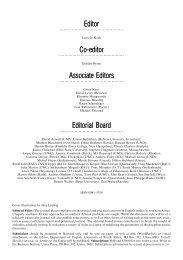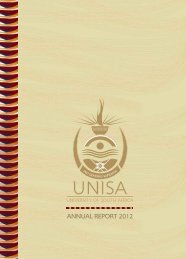pdf: 6.426kb - University of South Africa
pdf: 6.426kb - University of South Africa
pdf: 6.426kb - University of South Africa
You also want an ePaper? Increase the reach of your titles
YUMPU automatically turns print PDFs into web optimized ePapers that Google loves.
the twentieth century many ruptures <strong>of</strong> the rule <strong>of</strong> law.<br />
In the 1930s Brazil had a fascist regime led by an<br />
odious dictator who was inclined toward the Axis<br />
powers. In 1941 and in early 1942, the Brazilian<br />
people massively demonstrated for entry into the war<br />
with the allied powers. 8 Eventually, Brazil entered the<br />
war in August, 1942, in response to this enormous<br />
demand. In the process, one expeditionary force <strong>of</strong><br />
thirty-five thousand soldiers and aviators was sent to<br />
Italy, and a ferocious naval war raged in the <strong>South</strong>-<br />
Atlantic, which cost Brazil the loss <strong>of</strong> 98 per cent <strong>of</strong> its<br />
merchant navy. 9 Following the war, democracy was<br />
reinstated in 1945 only to be suppressed by a military<br />
coup in 1964, which started a regime that lasted until<br />
1986, when the rule <strong>of</strong> law was again reinstated in the<br />
wake <strong>of</strong> a great popular movement. Brazil had become<br />
a very complex society with the largest Italian<br />
population outside <strong>of</strong> Italy, estimated at 37 million<br />
people (the city <strong>of</strong> SaÄ o Paulo alone has more Italians<br />
than the combined populations <strong>of</strong> Rome and Milan)<br />
and the largest <strong>Africa</strong>n population outside <strong>of</strong> <strong>Africa</strong>.<br />
Millions <strong>of</strong> ethnic native Brazilians, the majority <strong>of</strong><br />
which integrated, live mostly but not exclusively in the<br />
centre and north <strong>of</strong> the country. In addition, there are<br />
numerous other nationalities, such as Arabs, Germans,<br />
Japanese, Koreans, Poles, in great numbers. Lastly,<br />
there is the phenomenon <strong>of</strong> widespread racial miscegenation,<br />
which has greatly contributed to the<br />
benign nature <strong>of</strong> our people and for its renowned<br />
tolerance.<br />
THE JUDICIARY IN BRAZIL<br />
Brazil's legal system has its roots in Roman law, with<br />
strong influence from various European sources, such<br />
as Portuguese (constitutional law), French (civil,<br />
commercial, company law), German (civil and criminal<br />
procedure) and Italian (criminal and labour)<br />
legislation. Some elements <strong>of</strong> US inspiration can also<br />
be found in the areas <strong>of</strong> competition; securities;<br />
environmental law; as well as in taxation. Unjust<br />
and/or impractical law is fiercely resisted by the civil<br />
society, in the best Tupi-Guarani tradition. Following<br />
the re-democratization <strong>of</strong> Brazil in 1986, a constituent<br />
assembly was formed with the mission <strong>of</strong> enacting a<br />
new constitution, which task was accomplished in<br />
1988. The Constitution <strong>of</strong> 1988 was, at very best,<br />
highly inadequate in time and space, and accordingly<br />
has already suffered 29 separate amendments. In the<br />
present federal administration only, the constitution<br />
has been amended by 19 different bills. 10 However,<br />
what is most striking about Brazil's constitution is not<br />
the number <strong>of</strong> amendments it has suffered, but the<br />
reforms it will still have to undergo, before it becomes<br />
a rational platform for the rule <strong>of</strong> law, federative pact,<br />
political balance and economic activities.<br />
The 1988 Constitution divided the Judiciary in<br />
ordinary and specialized courts. As Brazil is a<br />
federation, the ordinary court system is established<br />
at the state and federal levels. The ordinary courts<br />
comprise civil and criminal benches and the specialized<br />
courts attend to labour, military and electoral<br />
cases. Appeals may be filed to second and third<br />
instances. At the top <strong>of</strong> the pyramid, there is the<br />
constitutional court, the Federal Supreme Tribunal.<br />
The Superior Tribunal <strong>of</strong> Justice (STJ), with 33<br />
ministers, is the court <strong>of</strong> last resort for non-constitutional<br />
matters. All last resort tribunals are based in<br />
Brazil's capital, BrasõÂlia. With the re-democratization<br />
<strong>of</strong> the country and the adoption <strong>of</strong> the new constitution,<br />
Brazil became an increasingly litigious country,<br />
second only to the USA in terms <strong>of</strong> litigation. In 1997,<br />
four million suits were filed in the Brazilian courts.<br />
This number jumped to five million in 1999. The<br />
specialized labour courts alone tried 2,3 million cases<br />
in 1998. In the same year, the STJ decided 101 000<br />
cases with published opinions, whereas the STF, with<br />
11 justices, decided 52 000 cases.<br />
The 1988 Constitution allowed the Executive<br />
branch to legislate by means <strong>of</strong> decrees, Provisional<br />
Measures (MPs). In theory, those MPs should be<br />
enacted only in those cases <strong>of</strong> relevance and urgency<br />
and to be valid for only 30 days. However, in case<br />
Congress does not approve the law within 30 days,<br />
the administration is allowed to re-enact the measure.<br />
The current administration enacted 199 measures,<br />
which were re-enacted 3 336 times. For each MP,<br />
there are approximately 30 000 suits. Thus, the<br />
legislative effort <strong>of</strong> the FH Cardoso administration<br />
brought about, only in connection with MPs,<br />
5 970 000 suits. Federal, State and Municipal governments<br />
have a policy <strong>of</strong> litigating in bad faith and<br />
never settling cases, as the interest <strong>of</strong> the respective<br />
administrations is put above that <strong>of</strong> the public's. What<br />
counts is to procrastinate the obligation to pay to the<br />
extent possible, so that another administration will<br />
have to foot the bill. The State <strong>of</strong> SaÄ o Paulo alone, in<br />
spite <strong>of</strong> having the reputation <strong>of</strong> one <strong>of</strong> the best<br />
managed in the Brazilian federation, has approximately<br />
<strong>of</strong> US$ 6 billion dollars <strong>of</strong> judicial indemnification<br />
in arrears, and the municipality <strong>of</strong> SaÄ o Paulo,<br />
which does not enjoy the same reputation, US$ 1<br />
billion. As the State <strong>of</strong> SaÄ o Paulo refuses to pay those<br />
judicial awards, there were, in 1999, 1 103 requests<br />
for judicial intervention in the State's executive<br />
branch, whose governor has resorted to evading<br />
summons! 11<br />
In spite <strong>of</strong> such numbers, the Brazilian judiciary has<br />
only approximately 10 000 first-instance judges and<br />
200 000 active lawyers for a population <strong>of</strong> 150 million<br />
people. As in France, those judges are all civil servants<br />
subject to a public examination for qualification.<br />
Brazilian judges have benefited from continuing legal<br />
education programmes for more than ten years. In the<br />
higher courts, twenty per cent <strong>of</strong> members come from<br />
ISSN 0256±6060±Unisa Lat. Am. Rep. 16(2) 2000 39

















